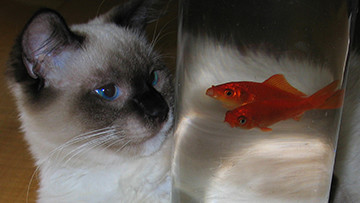In a child’s eyes a pet will never run out of lives
UK – Children don’t worry about elderly pets because they don’t understand death. Perhaps that’s why they’re so good at living.
One of the reasons to have pets, so we are told, is to teach children about the more sombre facts of life. Basically, they can be relied upon to die before too long – thereby giving your sprogs a gentle introductory course in grief and loss. But what happens if your pet refuses to die?
Splash, for example, is a 38-year-old goldfish, currently thought to be the oldest in the world. He was won at a Gloucestershire funfair in 1977, by the two young children of Richard and Anne Wright. The kids have long ago grown up and left home, but Splash is still determinedly circling his tank. “It feels like he’s been around forever,” Mr Wright told the papers this week. “We’ve never done anything out of the ordinary to care for him; we’ve just been blessed with a really hardy fish who’s lived through it all.”
My own apparently immortal pet, George, was born in 1993 – the year the European Union was formally established, and Charles and Diana split up. I was fresh out of university, and George was a tiny black starburst of fluff, so small he could sit in the palm of my hand.
Today, I am a matronly mother of three, and he is something close to a freak of nature. According to my own amateur research, he may be the third-oldest cat in Britain (behind 28-year-old Whiskey, of Buckinghamshire, and the current global record-holder, 29-year-old Pinky of Lincolnshire). And in his dotage, George has indeed provided a moral education – not for my children, but for me.
Elderly cats share many of the same frailties and foibles as elderly people. George comes down the stairs gingerly, conquering one step at a time, because of his arthritic legs. His eyes are cloudy, and his hearing erratic. He will often walk into a room and, forgetting what he came for, yowl with confusion.
Once the most dapper of cats – his glossy black fur and white bib accompanied in the mind’s eye by a top hat and cane – he can no longer groom himself, and hates to be combed. Instead, I have to snip out his dreadlocks as they arise, leaving him with the kind of haircut more often seen on tree-dwelling eco-protesters.
I love George as much as ever, but it turns out I am not much of a “carer”. Being older now myself, and afraid of death, I find his senectitude too upsetting. I don’t like stroking him any more, because his sharp bones frighten me. I worry in case he’s miserable or in pain, yet I can’t bring myself to have him put down.
My children, on the other hand, love him without prejudice. In the eyes of my three-year-old daughter, George is as cute as a newly minted kitten. She can’t keep her hands off him, picking him up and draping him over her shoulder like a fox-fur stole, or snuggling her face into his dandruffy pelt.
It reminds me of when my grandmother was dying, and I took my son – then two – to visit her in the nursing home. The sight of my stylish Granny slumped in a twisted nightie in that overheated sitting room was so shocking I could hardly look at her. But my son clambered straight on to her knee and, to her delight, started trying on her rings. While I was already grieving for Granny, he was having fun with her. Children don’t understand death – but perhaps that’s what makes them so good at living.
Author Jemima Lewis, curated from In a child’s eyes, the family pet will never run out of lives – Telegraph


Leave a Comment
You must be logged in to post a comment.